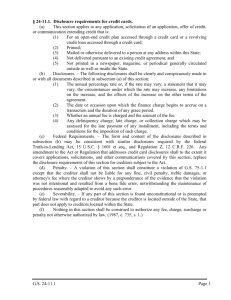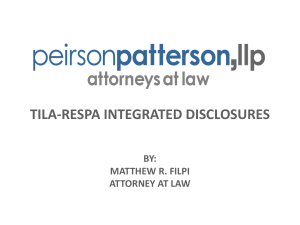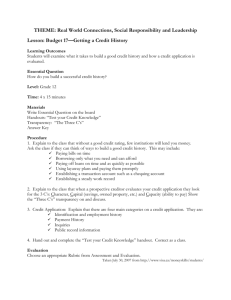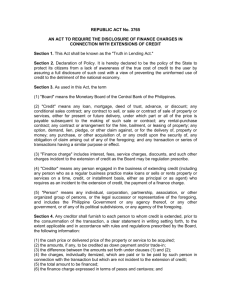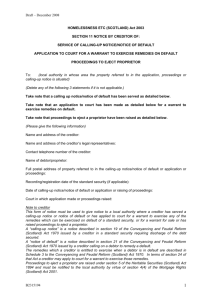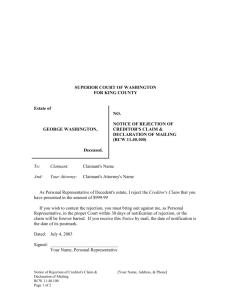TILA-RESPA Integrated Disclosures Frequently Asked
advertisement
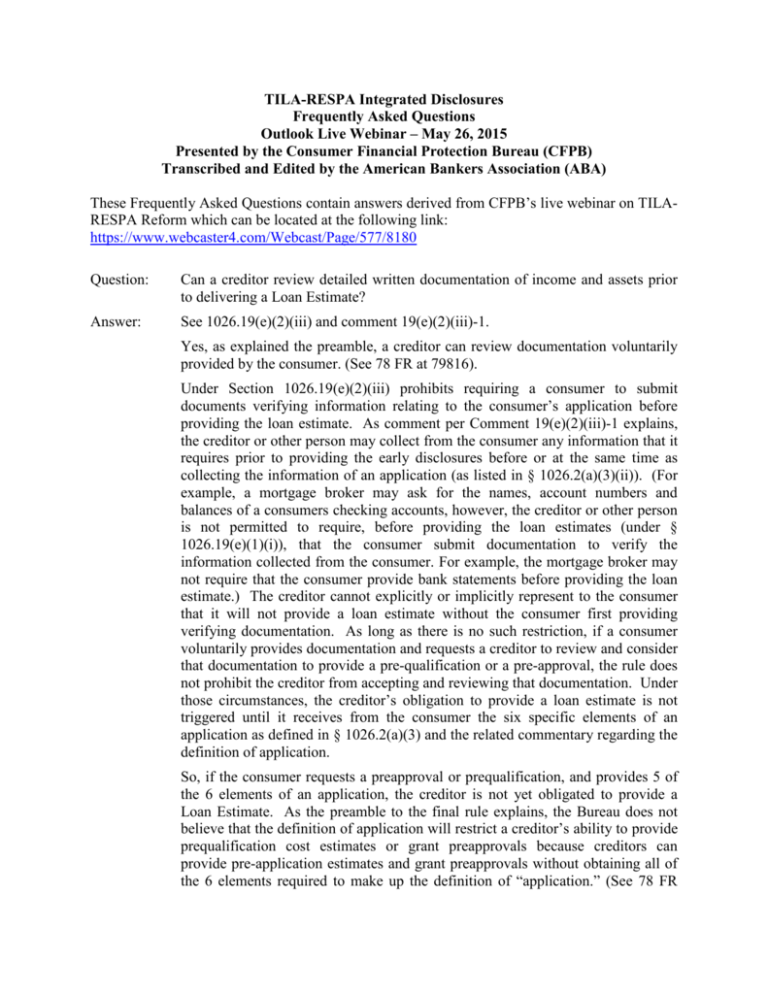
TILA-RESPA Integrated Disclosures Frequently Asked Questions Outlook Live Webinar – May 26, 2015 Presented by the Consumer Financial Protection Bureau (CFPB) Transcribed and Edited by the American Bankers Association (ABA) These Frequently Asked Questions contain answers derived from CFPB’s live webinar on TILARESPA Reform which can be located at the following link: https://www.webcaster4.com/Webcast/Page/577/8180 Question: Can a creditor review detailed written documentation of income and assets prior to delivering a Loan Estimate? Answer: See 1026.19(e)(2)(iii) and comment 19(e)(2)(iii)-1. Yes, as explained the preamble, a creditor can review documentation voluntarily provided by the consumer. (See 78 FR at 79816). Under Section 1026.19(e)(2)(iii) prohibits requiring a consumer to submit documents verifying information relating to the consumer’s application before providing the loan estimate. As comment per Comment 19(e)(2)(iii)-1 explains, the creditor or other person may collect from the consumer any information that it requires prior to providing the early disclosures before or at the same time as collecting the information of an application (as listed in § 1026.2(a)(3)(ii)). (For example, a mortgage broker may ask for the names, account numbers and balances of a consumers checking accounts, however, the creditor or other person is not permitted to require, before providing the loan estimates (under § 1026.19(e)(1)(i)), that the consumer submit documentation to verify the information collected from the consumer. For example, the mortgage broker may not require that the consumer provide bank statements before providing the loan estimate.) The creditor cannot explicitly or implicitly represent to the consumer that it will not provide a loan estimate without the consumer first providing verifying documentation. As long as there is no such restriction, if a consumer voluntarily provides documentation and requests a creditor to review and consider that documentation to provide a pre-qualification or a pre-approval, the rule does not prohibit the creditor from accepting and reviewing that documentation. Under those circumstances, the creditor’s obligation to provide a loan estimate is not triggered until it receives from the consumer the six specific elements of an application as defined in § 1026.2(a)(3) and the related commentary regarding the definition of application. So, if the consumer requests a preapproval or prequalification, and provides 5 of the 6 elements of an application, the creditor is not yet obligated to provide a Loan Estimate. As the preamble to the final rule explains, the Bureau does not believe that the definition of application will restrict a creditor’s ability to provide prequalification cost estimates or grant preapprovals because creditors can provide pre-application estimates and grant preapprovals without obtaining all of the 6 elements required to make up the definition of “application.” (See 78 FR 79767). So long as the consumer does not provide the 6 elements—for example, the property address—the creditor is not required to provide a loan estimate and may simply provide a preapproval or prequalification in compliance with current practice and other applicable law. However, if the consumer provides all six elements of the application, section 1026.19(e)(1)(iii) requires the creditor to provide a loan estimate. The fact that a consumer requested a preapproval or prequalification will not change the creditor’s obligation to provide a loan estimate. The creditor or other person shall not require a consumer to submit documents verifying information related to the consumer's application before providing the disclosures required by paragraph (e)(1)(i) of this section. Question: Does the new definition of “application” under the rule apply to home equity lines of credit (HELOCs)? Will the previous definition of “application” still apply to HELOCs and other products? Answer: See 1026.19(g). No. The new definition of application under the final rule does not apply to openend home equity lines of credit. To be clear, the TRID does not change the definition of application for open-end credit. Section 1026.19(g) was meant towards all the brochures and booklets required as part of RESPA and TILA. Therefore, the placement of this provision is not a modification of the definition of application for open end credit. As under current RESPA, creditors are required to provide the disclosures pursuant to 1026.40 for home equity plans and the relevant TILA booklet. However, creditors are not required to provide the current RESPA disclosures for HELOCS, nor will creditors be required to provide the TRID disclosures for open end HELOCS. Question: Can the disclosures be completed by hand printing? Answer: See Comments 37(o)(5)-2 and 38(t)(5)-2. Yes. Comment 2 to 1026. 37(o)(5) states that creditors are not required to use any particular method, be it by hand, computer, typewriter or other word processor to complete the Loan Estimate. The law only requires that-- (1) the information must be clear and legible, (2) the information must comply with the required formatting, including replicating bold font when required. There are various ways of doing so. Comment 2 to 1026.38(t)(5)-2 provides similar guidance for preparing the closing disclosure. Neither of these commentaries require the use of any particular method to complete the forms. We construe this to mean that no specific font size is required for completing the disclosures. Nonetheless, keep in mind that section 1026. 37(o)(1)(i) and 38(t)(1)(i) require making the disclosures clearly and conspicuously. A disclosure violates the rule if it is so small that it becomes illegible. This rule for completing the forms is different from the rules for printing the blank forms themselves. In previous webinars, CFPB stated that for federallyrelated mortgage loans under RESPA, the blank forms H-24 and H-25 are standard mandated forms, and the font size, labels and other text on the blank forms cannot be changed. Question: Comment 1 to Section 1026.37(h)(1)(ii) indicates that the amount disclosed is determined by subtracting the estimated total amount of payments to third parties not otherwise disclosed as Loan Costs or Other Costs. Some fees that are considered to be financed are already disclosed as Loan Costs. However, if these amounts are not considered financed, then the total Cash to Close would be too high because the financed fees are not subtracted. Can you please clarify? Answer: See 1026.37(h)(1)(ii), comment 37(h)(1)(ii)-1, 1026.19(e)(3), 1026.17(c). The standard calculating cash to close table is very specific as to how items are calculated. As set forth in Comment 37(h)(1)(ii)-1, the closing costs financed is determined by subtracting the estimated total amount of payments to third parties not otherwise disclosed as loan costs or other costs. Accordingly, the closing costs financed must determine which payments are applied towards the loan amount first, and it does so by deducting from the loan amount the amount of payments to third parties that have not yet been disclosed on the loan estimate. CFPB has received a number of questions regarding what constitutes third party charges not otherwise disclosed. These are third party charges not disclosed on the LE—this can include the sales price in a purchase transaction, a construction contract for a construction loan, state tax liens, credit card balances, phone payoffs, and any other third party charges that may not be fully known to the creditor at the time the LE is provided. Therefore they will not be disclosed pursuant to the best information reasonably available standard. Accordingly, if the amount is disclosed as a loan cost or other cost, it would not be included as part of this calculation. If there are no amounts left over to pay those charges that are disclosed, then -0- is disclosed as closing costs financed, and as a result of the calculation will be a negative number. When there are amounts that exceed these charges, then the closing costs financed is equal that difference, capped by the amount of total closing costs. Note that the amount disclosed in the calculating cash to close table are not subject to the analysis under 1026.19(e)(3); they are only subject to the basic standard that the creditor make the disclosures based on the best information reasonably available at the time the LE is provided under section 1026.17. [The CFPB slide sets forth the following slide—“Comment 37(h)(1)(ii)-1: The amount of closing costs financed disclosed under § 1026.37(h)(1)(ii) is determined by subtracting the estimated total amount of payments to third parties not otherwise disclosed pursuant to § 1026.37(f) and § 1026.37(g) from the total loan amount disclosed pursuant to § 1026.37(b)(1). If the result of the calculation is a positive number, that amount is disclosed as a negative number under § 1026.37(h)(1)(ii), but only to the extent that it does not exceed the total amount of lender credits disclosed under § 1026.37(g)(6)(ii). If the result of the calculation is zero or negative, the amount of $0 is disclosed under § 1026.37(h)(1)(ii).”] Question: Construction-to-permanent loans can be structured to have a single closing at the beginning of the process, or to have two closings, one at the beginning and then another at the end of the construction phase before the loan converts into permanent financing. How should a creditor disclose terms in a single-close construction-to-permanent loan transaction? Answer: See 1026.17(c)(6)(ii), comment 17(c)(6)-2. Before providing a response, there is important point that needs to be made clear—the LE and CD are governed by Regulation Z and its commentary. This means that many of the existing general provisions of Regulation Z apply to these disclosures. Under existing Regulation Z, creditors have a choice when making disclosures for construction loans. This was not modified by TRID rules. Section 1026.17(c)(6)(ii) permits creditors to disclose transactions where the construction phase and the permanent phase as either a single transaction or as two separate transactions. This is not dependent on the number of state law closings that occur, but must still reflect the terms of the legal obligation between the creditor and the consumer. When a multiple-advance loan to finance the construction of a dwelling may be permanently financed by the same creditor, the construction phase and the permanent phase may be treated as either one transaction or more than one transaction. Comment 17(c)(6)-2 specifically states that this rule is available whether the consumer is initially obligated to accept construction financing only, or is obligated to accept construction and permanent financing from the outset. Accordingly, in circumstances where there is a single closing, a creditor may still disclose two separate transactions, on two Les and two CDs. To specifically address this particular question, if the creditor chooses to disclose a single-close construction-to-permanent financing as two transactions on the disclosures, comment 2 states that both sets must be given to the consumer initially because both transactions will be consummated at that time. Note also that Appendix D to Regulations Z contains different ways to calculate the APR and certain other disclosures on the forms, based on the creditor’s decision to disclose the construction-permanent loan as a single transaction or multiple transactions. [The slides presented by the Bureau set forth the following test: Comment 17(c)(6)-2: CONSTRUCTION LOANS. Section 1026.17(c)(6)(ii) provides a flexible rule for disclosure of construction loans that may be permanently financed. These transactions have 2 distinct phases, similar to 2 separate transactions. The construction loan may be for initial construction or subsequent construction, such as rehabilitation or remodeling. The construction period usually involves several disbursements of funds at times and in amounts that are unknown at the beginning of that period, with the consumer paying only accrued interest until construction is completed. Unless the obligation is paid at that time, the loan then converts to permanent financing in which the loan amount is amortized just as in a standard mortgage transaction. Section 1026.17(c)(6)(ii) permits the creditor to give either one combined disclosure for both the construction financing and the permanent financing, or a separate set of disclosures for the 2 phases. This rule is available whether the consumer is initially obligated to accept construction financing only or is obligated to accept both construction and permanent financing from the outset. If the consumer is obligated on both phases and the creditor chooses to give 2 sets of disclosures, both sets must be given to the consumer initially, because both transactions would be consummated at that time. (Appendix D provides a method of calculating the annual percentage rate and other disclosures for construction loans, which may be used, at the creditor's option, in disclosing construction financing.)] Question: If there is a valid changed circumstance or a borrower requested change that triggers another third-party service that the creditor permits the consumer to shop for, should the list of service providers be updated and re-disclosed, or is the written list of service providers required to be provided only once upon providing the initial Loan Estimate? Answer: See 1026.19(e)(1)(vi)(C), 1026.19(e)(3), 1026.19(e)(3)(iii)(D). A creditor may update and re-disclose the written list of service providers to reflect the new service that is added as a result of a changed circumstance or borrower-requested change. This question deals with 1026.19(e)(1)(vi)(C) , which requires the creditor to provide a written list of providers to accompany the loan estimate for any settlement service that the consumer can shop. When an event that would permit resetting of tolerances or variations under Section 1026.19(e)(3)(iv) occurs, and an additional settlement service is required, the creditor may disclose service providers of that additional service on the written list at the same time as it issued the revised LE. Although the regulation did not expressly address this scenario, we recognize that a creditor may want to permit the consumer to shop for this new service. There are two ways that a creditor may approach adding the new service to the written list. First, the creditor may include the additional service and provide an updated written list. Or second, because the rule does not require the written list to be updated and accompany a revised LE, the creditor may provide a written list showing only service providers of the additional service. Either method would comply with the rule. Note however, that if the creditors intends to allow the consumer to shop for the additional service, but fails to provide an updated or revised written list of service providers, that service would be subject to zero tolerance. Question: In a scenario where the creditor’s estimate of closing costs changes, but the prior estimate remains “in good faith” for purposes of Section 1026.19(e)(3), is the creditor prohibited from providing the consumer with a revised disclosure? Answer: See Comment 19(e)(3)(iv)(A)-1.ii. As stated in Comment 19(e)(3)(iv)(A)-1.ii, the rule does not prohibit the creditor from issuing revised disclosures for informational purposes. When estimates change, sections 1026.19(e)(3)(i)-(iii) determine whether the changes are in good faith. (To be clear, throughout this answer, the term “in good faith” will refer to the good faith determination under that specific section—1026.19(e)(3).) Bear in mind that the loan estimate is a disclosure to the consumer—the LE alone will not indicate whether estimates are in good faith. To determine whether estimates are in good faith, the creditor must perform the analysis under 1026.19(e)(3)(i)(iii). If the Creditor performs that analysis and determines that changed estimates are not in good faith, then, under certain circumstances, section 1026.19(e)(3)(iv) and (e)(4) may allow the creditor to reset the estimates in order to be good faith. When resetting the estimates under those circumstances, the rule requires the creditor to provide the consumer with a revised loan estimate or, in certain instances explained in Comment 19(e)(4)(ii)-1, a closing disclosure. But even if the creditor determined that changed estimates remain in good faith, the rule does not prohibit the creditor from issuing an updated disclosure reflecting the changed estimates—and a creditor has the option of doing so. Keep in mind, however, that in that case, the updated disclosure will not impact the good faith analysis under 1026.19(e)(3)(i) - (iii). And the creditor must have a mechanism for tracking which disclosure controls for purposes of determining good faith. Example: The scenario in comment 19(e)(3)(iv)(A)-1.ii applies—assume that a creditor previously provided a $400-dollar estimate of title fees. For purposes of determining good faith, title fees are generally included in the 10% tolerance category. This scenario further assumes that a changed circumstance increases title fees to $500, and that the sum of all costs subject to the 10% tolerance category has not increased by more than 10%. Under section 1026.19(e)(3)(ii), the prior estimate remains in good faith, therefore, the rule does not permit the creditor to reset the estimate. However, the creditor has the OPTION of providing the consumer with an updated disclosure reflecting the increase in title fees. When the creditor performs analysis under 1026.19(3)(i-iii), the actual title fees of $500 may not be compared to the revised estimates of 500. Instead they must be compared to the originally estimated title fees of $400, because the changed circumstance did not cause the sum of all costs subject to the 10% category to increase by more than 10%. Question: The current HUD-1 has a comparison chart to show the applicable tolerance levels and how the charges compare. Where is the equivalent chart on the Closing Disclosure? Answer: See Form H-25(F) from appendix H. There is no chart in the closing disclosure equivalent to the HUD-1 comparison chart. The creditor is responsible for tracking charges off-sheet ensure that the amounts disclosed on the LE were made in good faith and that the charges at closing do not exceed the applicable tolerances. To the extent there are any refunds from the creditor to the consumer from a violation of the good faith standard, the refunds should be disclosed with lender credits on page two of the CD. As shown in the figure below, any refunds should be itemized in the manner shown in Form H-25(F) from appendix H. Question: If the owner’s title policy disclosed on the Closing Disclosure is not the same amount of the premium quoted by the title underwriter, how does a creditor show that a seller has agreed to pay for the owner’s title insurance? Answer: See 1026.38(f) and (g), 1026.38(k)(2)(vii) and (viii), comments 37(f)(2)-4, 37(f)(3)-3, and 37(g)(4)-2. This question was analyzed and debated during the notice and comment rulemaking process, as different states provide for different methods of calculating and disclosing title insurance costs in light of potential discounts. The basic approach of the TRID rule is to disclose the charges that the creditor requires the consumer to pay. In the context of title insurance, the creditor requires the consumer to pay for the costs of the lender’s title policy, generally. The creditor’s requirement is not predicated on whether the consumer obtains an owner’s title insurance policy, thus, the consumer is always responsible to the creditor to pay for a lender’s policy and title insurance. Whether the consumer purchases an owner’s title policy does not change this responsibility to the creditor. Under the TRID forms, the Bureau ultimately determined that the most transparent way of disclosing the cost to consumers is to require that lender’s and owner’s title insurance policies be disclosed as separate items, with any discounts applied to reduce the cost disclosed for the owner’s title policy. Note that this may actually make the cost of the owner’s title policy on the LE and CD to be less expensive than it does on some state disclosures. The sum of the disclosed amount of owner’s and lender’s title as disclosed on the TRID forms should equal the sum on any state-mandated disclosures. (See Comment 37(g)(4)-2: “SIMULTANEOUS TITLE INSURANCE PREMIUM RATE IN PURCHASE TRANSACTIONS. The premium for an owner's title insurance policy for which a special rate may be available based on the simultaneous issuance of a lender's and an owner's policy is calculated and disclosed pursuant to § 1026.37(g)(4) as follows: (i)The title insurance premium for a lender's title policy is based on the full premium rate, consistent with § 1026.37(f)(2) or (f)(3). (ii)The owner's title insurance premium is calculated by taking the full owner's title insurance premium, adding the simultaneous issuance premium for the lender's coverage, and then deducting the full premium for lender's coverage.) Note that if the simultaneous issuance calculations were disclosed in the same manner as they are in some states, the amount disclosed for the lender’s title insurance policy would be negligible or zero. In circumstances where the consumer declines an owner’s title policy, the lender’s title insurance cost can then increase substantially, resulting in a higher amount of closing costs than can be anticipated by the creditor or the consumer. The consumer may thus be led to believe that the incremental cost of the owner’s title insurance is much higher than disclosed on the loan estimate. This approach could lead to consumer confusion. For a thorough discussion of this analysis, please see the preamble to the final rule at 78 FR 79963-65. More consumer information on these costs is provided in the “Your Home Loan” Toolkit, released by the Bureau in early April 2015. With regard to the question of how the creditor shows the allocation of costs when the seller has agreed pay for the owner’s title insurance cost as part of the purchase and sale contract with the consumer—Because the rule provides that the incremental cost of the owner’s title insurance is to be disclosed on the LE and CD, simply shifting the incremental cost of the owner’s title insurance to the seller on the CD may not completely reflect the amount that the seller has agreed to pay for the owner’s title policy. If there is an additional amount on the seller’s credit, there are at least three ways in which the additional credit between the seller and the consumer may be disclosed on the CD. · First, the remaining credit could be applied towards any remaining title insurance costs, including the lender’s title insurance costs. See § 1026.38(f) & (g). · Second, the remaining credit can be considered to be a general seller credit, and disclosed as such in the summaries of transactions table on page 3 of the CD. See § 1026.38(k)(2)(vii). · Third, some in the industry have suggested providing a credit specifying the remaining amount for the owner’s title insurance cost again in the summaries of transactions table on page 3 of the CD. See § 1026.38(t)(2)(viii). Any one of these three methods to disclose the remaining amount of a seller’s credit for an owner’s title policy is permissible under the final rule. Question: Can market participants place their logo on the Toolkit cover? Answer: See 1026.19(g)(2)(iv). Yes. Market participants may place their logo on the cover of the Special Information booklet, also known as the Toolkit. As the above section explains, the cover of the booklet may be in any form and may contain any drawings, pictures or artwork, provided that the title appearing on the cover shall not be changed. Names, addresses, and telephone numbers of the creditor or others and similar information may appear on the cover, but no discussion of the matters covered in the booklet shall appear on the cover. References to HUD on the cover of the booklet may be changed to references to the Bureau. Question: If a creditor makes the Toolkit available on its website, does that satisfy the rule’s delivery requirement? Answer: See 1026.19(g)(1)(i). No. By simply making special information booklet available on its website, a creditor does not satisfy the rule’s delivery requirement. Section 1026.19(g)(1)(i) requires that the creditor deliver or place in the mail the special information booklet not later than three business days after the consumer's application is received. As that section also explains, if the consumer uses a mortgage broker, the mortgage broker shall provide the special information booklet and the creditor need not do so. The Bureau encourages all market participants to provide the booklet to consumers at any other time, preferably, as early in a home or mortgage shopping process as possible. (However, if the creditor denies the consumer's application before the end of the three-business-day period, the creditor need not provide the booklet.)

